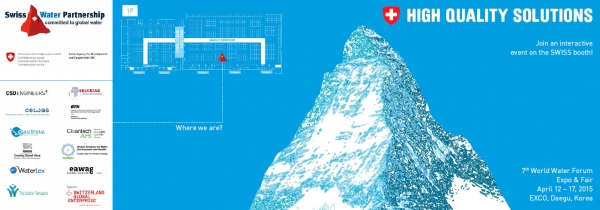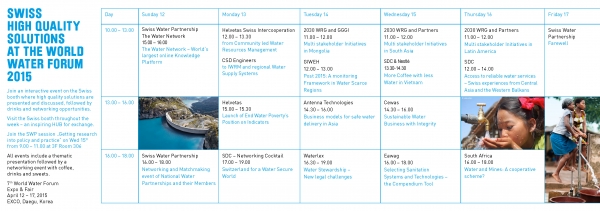Peru announces largest commitment to green water infrastructure for any Latin American city


Please join Peru’s water regulator SUNASS, the Swiss Water Partnership, and Forest Trends for a special event announcing the largest financial commitment to green water infrastructure for any Latin American city.
- When: Tuesday, April 14, 2015 at 10:00 – 11:00 AM
- Where: The Swiss Booth, EXCO Expo & Fair, Daegu (for a map, please visit: http://www.swisswaterpartnership.ch/wp-content/uploads/2015/03/SWP_FLYER_World-Water-Forum_.pdf)
- Presenter: Fernando Momiy Hada, President of the Board, SUNASS (National Superintendent of Water and Sanitation Services of Peru)
- Facilitators: Olga Darazs, President of the Swiss Water Partnership, and Marco Daniel, Coordinator of the Swiss Water Partnership
Just a few weeks ago, Peru’s water utility regulator approved the creation of two new funds that will finance innovative and sustainable water resource management for Lima, the capital of Peru and the second-largest desert city in the world. The decision creates a green infrastructure fund as well as a fund for climate change adaptation and disaster risk reduction, together worth 4.8% of the Lima water utility’s 5-year budget (approximately USD 112 million). See below for more details on this news.
- For more information on the event, please contact Gena Gammie (ggammie@forest-trends.org).
Lima is the world’s second-largest desert city after Cairo, and its water supply struggles to meet the demands of its 9 million residents year-round: in the wet season, the rivers that flow down from the Andes break their banks, as is happening now, while in the dry season, they slow to a trickle. Just two weeks ago, massive landslides killed 9 people, left hundreds homeless, and caused severe damage to major infrastructure just a few kilometers upstream of Lima. Climate change is likely to exaggerate these peaks and troughs.
To meet the challenge, the city’s water utility, SEDAPAL (Servicio de Agua Potable y Alcantarillado de Lima), plans to funnel nearly 5% of the water fees it collects from users into addressing this issue. This includes management funds for “green infrastructure,” which comprises the restoration of everything from the natural wetlands that have always sponged up water in the wet season (and released it into the mountain streams in the dry season) to pre-Incan “amunas” that siphon water off high-altitude streams in the wet season and funnel it into the mountain itself, where it filters down through the rocks over several months and emerges from springs in the dry season.
“As the regulatory agency of Water and Sanitation in Perú, it is our responsibility to protect and preserve the river basins,” says Fernando Momiy Hada, President of national water regulator SUNASS (Superintendencia Nacional de Servicios de Saneamiento). “’Gray infrastructure tools,’ like pipes and sewers, have their place, but we need to restore and protect the watershed, and re-grout the amunas to preserve and increase the quality and the quantity of water in the river basins.”
The funds will be divided between two activities: 1% of the total water tariff, or PEN 70 million (USD 23 million), will go explicitly to green infrastructure; while 3.8%, or PEN 266 million (USD 89 million) will be used for climate change adaptation and disaster risk reduction more generally.
The PEN 70 million investment is more than any other Latin American city or water utility has ever committed to green infrastructure. In addition to restoring the ancient amunas, the funds will be used to help farmers manage their livestock in a way that restores degraded puna grasslands, as well as to restore natural wetlands that have been drained for agriculture.
Lima’s challenges are far from unique. Due to extreme water shortages, California is imposing dramatic water use reductions and, as a result of an extreme drought, São Paulo, Brazil, the world’s fourth-largest city, is contemplating similar measures. The water crisis is front page news every day these days – and Lima is taking a very important and big step into the right direction.
“Latin America is a hotbed of innovation when it comes to tackling the global water crisis, and Peru is a leading country in Latin America,” says Michael Jenkins, President and CEO of US NGO Forest Trends, which conducted an assessment of the cost-effectiveness of green infrastructure for Lima’s water supply. “This is exactly the kind of leadership and creativity we need if we’re going to confront similar challenges around the world.”
SUNASS tentatively approved the proposal on March 26, but final approval will likely take place after a public hearing later this month. Lima’s water utility, SEDAPAL, had submitted a proposed budget that included a plan for investing PEN 12 million (USD 4 million) in green infrastructure for the city. The approved budget is nearly six-fold that proposal.

Facebook comments